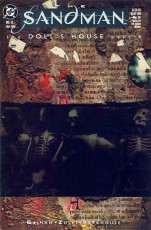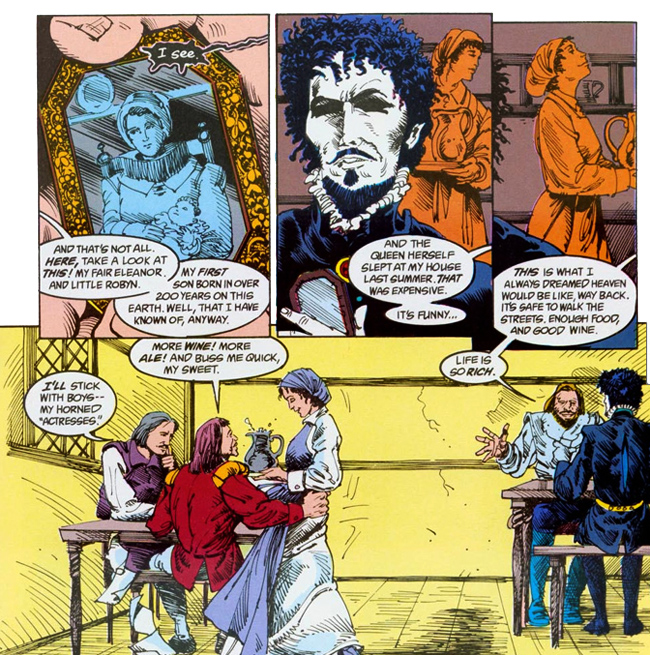What might an average fellow do with infinity? Would immortality turn out to be nothing but endless boredom and interminable suffering?
Your Major Spoilers (retro) review awaits!
 SANDMAN #13
SANDMAN #13
Writer: Neil Gaiman
Artist: Michael Zulli
Inker: Steve Parkhouse
Colorist: Robbie Busch
Letterer: Todd Klein
Editor: Karen Berger
Publisher: DC Comics/Vertigo
Cover Price: $1.50
Current Near-Mint Pricing: $4.00
Previously in Sandman: Morpheus is one of the seven Endless, anthropomorphic personifications of universal constants, each of whom has a particular job and function in the universe. Morpheus is the lord of dreams, the overseer of the unconscious, and has historically been the living incarnation of “a stick in the mud,” so when his sister recommends that they enter a drinking establishment, he is less than enthusiastic…

Enter Robert “Hob” Gadling, man-about-town and general pub-sayer-of-things. Hanging out with his friends, Hob chooses to expostulate on his theory of life, death and mortality, not knowing that the actual representation of Death herself is sitting within earshot…

“Nobody HAS to die,” opines Master Gadling, to the derision of his friends (and the nearby poet, Geoffrey Chaucer, who has been trying to defend his decision to write mostly ribald stories rather than Piers Plowman.) Death and Dream, overhearing the whole conversation, confer amongst themselves and decide that this mortal might make for an interesting experiment. Dream approaches Hob with a proposition. (Minds out of the gutter, Faithful Spoilerites…)

100 years hence, Hob and the Lord of Dreams meet again, and Morpheus explains that Death has agreed not to take Hob’s life unless and until Hob decides he WANTS to die. Hob sees little chance of that, remarking on the wonderful advances of the past century, from chimneys to playing cards to even the amazing handkerchief!

100 years later, as young Will Shakespeare takes advice from his more experience friend Kit Marlowe, Hob (now Sir Robert Gadlen) once again meets with the incarnation of the Dreaming, reveling in the wonderful success his life has become, sharing that the Queen herself even slept at his house. As for his family, Hob likewise finds himself blessed…

Sandman benefited from many different pencilers during its run, and while Michael Zulli isn’t one of the most notable names to work on Morpheus’ tales, I love the way he makes subtle changes to Hob and Dream alike to show us how the centuries have changed them in more than just matters of fashion. There are some issues with the coloring on the book, coming across as a bit orangey and more pastel than the tale seems to warrant, but I chalk some of that up to late 80s printing processes. When Morpheus returns to the pub in the next century, though, he is annoyed to find that Gadling is missing… until a commotion at the door reveals the truth…

“I’ve hated every second of the last eighty years,” spits a bitter, filthy Hob. But when asked if he is tired of life yet, he thinks for long moments, then decides, “I’ve got so much to live for!” When next they meet, Hob is once again in good spirits, having taken up a new trade, that of slavery. Their meeting is interrupted by neer-do-well Lady Johanna Constantine, who believes that she can gain power, as legends tell that, once a century, The Devil and The Wandering Jew meet in this particular tavern. Her threat is of little import to one of The Endless, and they quickly part, with Morpheus warning Hob that he should find himself a new line of business. 100 years later, they’ve found themselves a new tavern, and Hob has a new understanding of his immortality…

There are a lot of amazing issues of Sandman out there, but this one is a personal favorite, not just for the time-traveling antics (although, those are fascinating, especially the subtle differences between the centuries) but for the way Hob and Morpheus slow build a bit of a rapport throughout the centuries. Most importantly, between their meeting the 1800s and what was then the present day, Morpheus spent nearly a century trapped in a tiny cell, and was forced to rebuild his life and his kingdom, as well as re-assessing his own state of being. Thus, when the 1990s roll around…

I also love the fact that all the dialogue in the modern-day pub is exactly the same (given a few topical references) as the dialogue we hear over the previous six centuries, reminding us that the more things change, the more cliché blah blah blah fishcakes. The final panel is one of the most meaningful Morpheus moments, as well, showing how much even one of the Endless can evolve emotional, given the proper circumstances. Sandman #13 is a wonderful read, with a nice final panel, some hidden depths, and lovely art (albeit not the best that Sandman has to offer, and a bit ill-suited by the coloring) earning 4.5 out of 5 stars overall.




2 Comments
The relationship between Dream & Hob is always one of my favorite aspects of the series. If there were ever to be an adaption of the Sandman, and left out this dynamic, it would be sorely missed.
Easily one of my favorite single issues of comics.
While I really had enjoyed Sandman up to this point, this was the issue that really sunk home the quality of the writing. Gaiman’s seems to turn the lessons of other similar immortal stories on their head. Hob never regrets his what he wished for, and he never seems to change or be out of place. A commentary that maybe humans haven’t gained much in all these years.